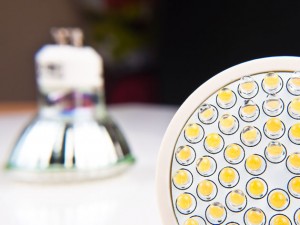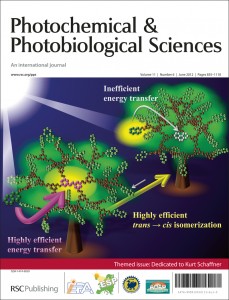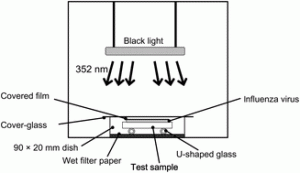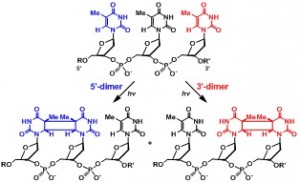This month sees the following articles in PPS that are in the top ten most accessed:-
Pathways of electron transfer photosensitized by thiacyanine dimers
A. K. Chibisov and G. V. Zakharova
Photochem. Photobiol. Sci., 2012,11, 893-897, DOI: 10.1039/C1PP05273J, Paper
Stem cell-based photodynamic therapy
Tej B. Shrestha, Gwi M. Seo, Matthew T. Basel, Mausam Kalita, Hongwang Wang, David Villanueva, Marla Pyle, Sivasai Balivada, Raja Shekar Rachakatla, Heather Shinogle, Prem S. Thapa, David Moore, Deryl L. Troyer and Stefan H. Bossmann
Photochem. Photobiol. Sci., 2012, Advance Article, DOI: 10.1039/C2PP05417E, Paper
ß-Cyclodextrin polymer nanoparticles as carriers for doxorubicin and artemisinin: a spectroscopic and photophysical study
Resmi Anand, Francesco Manoli, Ilse Manet, Samia Daoud-Mahammed, Valentina Agostoni, Ruxandra Gref and Sandra Monti
Photochem. Photobiol. Sci., 2012, Advance Article, DOI: 10.1039/C2PP25014D, Paper
On the genesis of heterogeneous photocatalysis: a brief historical perspective in the period 1910 to the mid-1980s
N. Serpone, A. V. Emeline, S. Horikoshi, V. N. Kuznetsov and V. K. Ryabchuk
Photochem. Photobiol. Sci., 2012, Advance Article, DOI: 10.1039/C2PP25026H
Controlled surface trap state photoluminescence from CdS QDs impregnated in poly(methyl methacrylate)
Santanu Karan, Manisree Majumder and Biswanath Mallik
Photochem. Photobiol. Sci., 2012, Advance Article, DOI: 10.1039/C2PP25023C, Paper
Photo-oxidation of proteins
David I. Pattison, Aldwin Suryo Rahmanto and Michael J. Davies
Photochem. Photobiol. Sci., 2011, Advance Article, DOI: 10.1039/C1PP05164D
Photoactivatable fluorophores and techniques for biological imaging applications
Wen-hong Li and Genhua Zheng
Photochem. Photobiol. Sci., 2012, Advance Article, DOI: 10.1039/C2PP05342J
On the singlet states of porphyrins, chlorins and bacteriochlorins and their ability to harvest red/infrared light
Carlos J. P. Monteiro, J. Pina, Mariette M. Pereira and Luis G. Arnaut
Photochem. Photobiol. Sci., 2012, Advance Article, DOI: 10.1039/C2PP25021G, Paper
UV wavelength-dependent DNA damage and human non-melanoma and melanoma skin cancer
Gerd P. Pfeifer and Ahmad Besaratinia
Photochem. Photobiol. Sci., 2012,11, 90-97, DOI: 10.1039/C1PP05144J
Applications of p-hydroxyphenacyl (pHP) and coumarin-4-ylmethyl photoremovable protecting groups
Richard S. Givens, Marina Rubina and Jakob Wirz
Photochem. Photobiol. Sci., 2012, 11, 472-488, DOI: 10.1039/C2PP05399C
Why not take a look at the articles today and blog your thoughts and comments below.
Fancy submitting an article to PPS? Then why not submit to us today or alternatively email us your suggestions.
Comments Off on Top ten most accessed articles in May
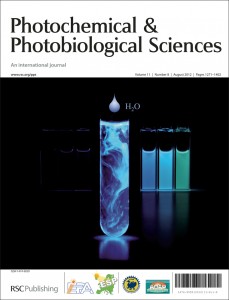 PPS issue 8 is now online; you can read the issue here. The front cover highlights work from Seiji Tobita and co-workers in Japan. Their paper demonstrates that a coumarin analogue 8-methoxy-4-methyl-2H-benzo[g]chromen-2-one (MMBC), is almost non-fluorescent in non-polar media, whereas it exhibits dramatically enhanced fluorescence in polar protic solvents. The team investigate the mechanistic features of the significant solvent effects on the fluorescence properties of MMBC and a related compound using time-resolved fluorescence and photoacoustic measurements and by theoretical calculations.
PPS issue 8 is now online; you can read the issue here. The front cover highlights work from Seiji Tobita and co-workers in Japan. Their paper demonstrates that a coumarin analogue 8-methoxy-4-methyl-2H-benzo[g]chromen-2-one (MMBC), is almost non-fluorescent in non-polar media, whereas it exhibits dramatically enhanced fluorescence in polar protic solvents. The team investigate the mechanistic features of the significant solvent effects on the fluorescence properties of MMBC and a related compound using time-resolved fluorescence and photoacoustic measurements and by theoretical calculations.










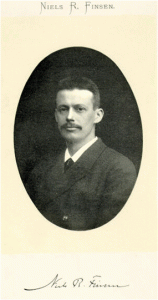
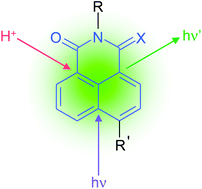 Naphthalenic compunds have many applications in the fluorescent sensing/switching/logic systems. In this paper from A. Prasanna de Silva and colleagues at Queen’s University in Belfast, the team examine a naphthalenic compund which is a fluorescent photoinduced electron transfer system of the ‘fluorophore-spacer-receptor’ format, whose fluorescence responds sharply to H+. Several structural variations of this compund are examined and it is deomonstrated that the naphthalenic derivatives display a range of H+-induced fluorescence switching actions.
Naphthalenic compunds have many applications in the fluorescent sensing/switching/logic systems. In this paper from A. Prasanna de Silva and colleagues at Queen’s University in Belfast, the team examine a naphthalenic compund which is a fluorescent photoinduced electron transfer system of the ‘fluorophore-spacer-receptor’ format, whose fluorescence responds sharply to H+. Several structural variations of this compund are examined and it is deomonstrated that the naphthalenic derivatives display a range of H+-induced fluorescence switching actions.
